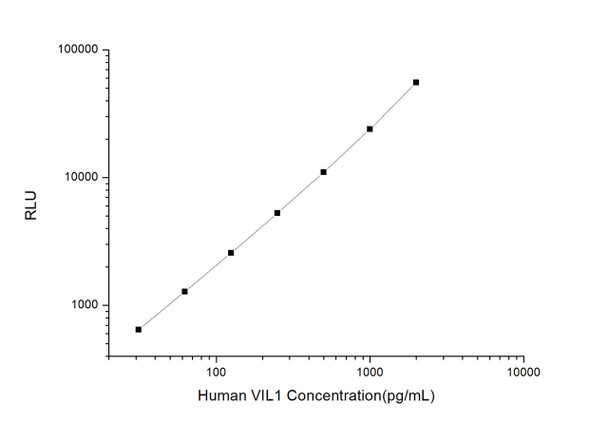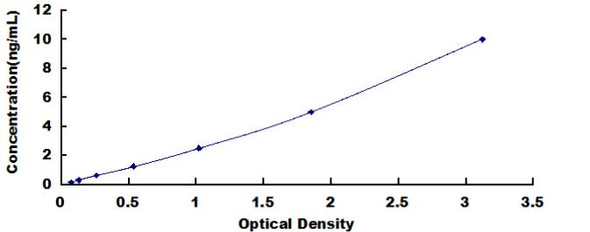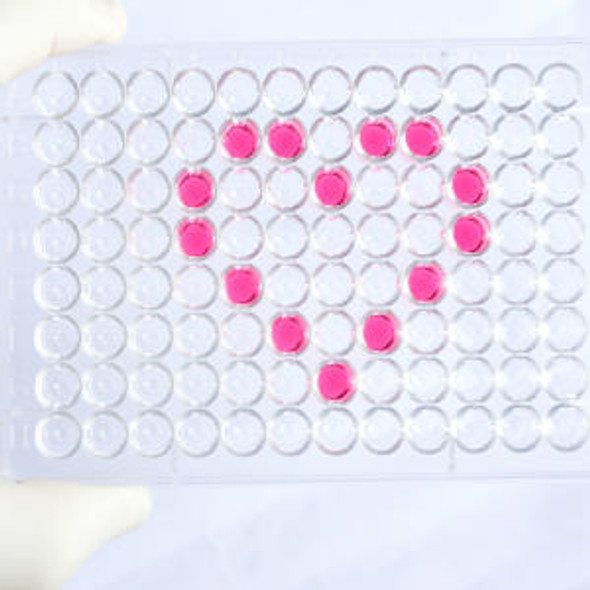Human Cell Death ELISA Kits
Human VIL-1 (Villin 1) CLIA Kit (HUES01278)
- SKU:
- HUES01278
- Product Type:
- ELISA Kit
- ELISA Type:
- CLIA Kit
- Size:
- 96 Assays
- Sensitivity:
- 18.75pg/mL
- Range:
- 31.25-2000pg/mL
- ELISA Type:
- Sandwich
- Reactivity:
- Human
- Sample Type:
- Serum, plasma and other biological fluids
- Research Area:
- Cell Death
Description
| Assay type: | Sandwich |
| Format: | 96T |
| Assay time: | 4.5h |
| Reactivity: | Human |
| Detection method: | Chemiluminescence |
| Detection range: | 31.25-2000 pg/mL |
| Sensitivity: | 18.75 pg/mL |
| Sample volume: | 100µL |
| Sample type: | Serum, plasma and other biological fluids |
| Repeatability: | CV < 15% |
| Specificity: | This kit recognizes Human VIL1 in samples. No significant cross-reactivity or interference between Human VIL1 and analogues was observed. |
This kit uses Sandwich-CLIA as the method. The micro CLIA plate provided in this kit has been pre-coated with an antibody specific to Human VIL1. Standards or samples are added to the appropriate micro CLIA plate wells and combined with the specific antibody. Then a biotinylated detection antibody specific for Human VIL1 and Avidin-Horseradish Peroxidase (HRP) conjugate are added to each micro plate well successively and incubated. Free components are washed away. The substrate solution is added to each well. Only those wells that contain Human VIL1, biotinylated detection antibody and Avidin-HRP conjugate will appear fluorescence. The Relative light unit (RLU) value is measured spectrophotometrically by the Chemiluminescence immunoassay analyzer. The RLU value is positively associated with the concentration of Human VIL1. The concentration of Human VIL1 in the samples can be calculated by comparing the RLU of the samples to the standard curve.
| UniProt Protein Function: | Villin: Epithelial cell-specific Ca(2+)-regulated actin- modifying protein that modulates the reorganization of microvillar actin filaments. Plays a role in the actin nucleation, actin filament bundle assembly, actin filament capping and severing. Binds phosphatidylinositol 4,5-bisphosphate (PIP2) and lysophosphatidic acid (LPA); binds LPA with higher affinity than PIP2. Binding to LPA increases its phosphorylation by SRC and inhibits all actin-modifying activities. Binding to PIP2 inhibits actin-capping and -severing activities but enhances actin-bundling activity. Regulates the intestinal epithelial cell morphology, cell invasion, cell migration and apoptosis. Protects against apoptosis induced by dextran sodium sulfate (DSS) in the gastrointestinal epithelium. Appears to regulate cell death by maintaining mitochondrial integrity. Enhances hepatocyte growth factor (HGF)-induced epithelial cell motility, chemotaxis and wound repair. Upon S. flexneri cell infection, its actin-severing activity enhances actin-based motility of the bacteria and plays a role during the dissemination. Monomer. Homodimer; homodimerization is necessary for actin-bundling. Associates with F-actin; phosphorylation at tyrosines residues decreases the association with F-actin. Interacts (phosphorylated at C-terminus tyrosine phosphorylation sites) with PLCG1 (via the SH2 domains). Interacts (phosphorylated form) with PLCG1; the interaction is enhanced by hepatocyte growth factor (HGF). Specifically expressed in epithelial cells. Major component of microvilli of intestinal epithelial cells and kidney proximal tubule cells. Expressed in canalicular microvilli of hepatocytes. Belongs to the villin/gelsolin family. |
| UniProt Protein Details: | Protein type:Actin-binding; Motility/polarity/chemotaxis Chromosomal Location of Human Ortholog: 2q35 Cellular Component: ruffle; filopodium tip; microvillus; lamellipodium; cytoplasm; actin filament bundle; filopodium Molecular Function:actin filament binding; identical protein binding; protein binding; phosphatidylinositol-4,5-bisphosphate binding; protein homodimerization activity; caspase inhibitor activity; calcium ion binding Biological Process: epidermal growth factor receptor signaling pathway; actin filament severing; actin filament depolymerization; actin filament capping; negative regulation of caspase activity; actin nucleation; regulation of cell shape; response to bacterium; epithelial cell differentiation; actin filament polymerization; regulation of actin nucleation; positive regulation of actin filament bundle formation; protein complex assembly; positive regulation of cell migration |
| NCBI Summary: | This gene encodes a member of a family of calcium-regulated actin-binding proteins. This protein represents a dominant part of the brush border cytoskeleton which functions in the capping, severing, and bundling of actin filaments. Two mRNAs of 2. 7 kb and 3. 5 kb have been observed; they result from utilization of alternate poly-adenylation signals present in the terminal exon. [provided by RefSeq, Jul 2008] |
| UniProt Code: | P09327 |
| NCBI GenInfo Identifier: | 224471905 |
| NCBI Gene ID: | 7429 |
| NCBI Accession: | P09327. 4 |
| UniProt Secondary Accession: | P09327,Q53S11, Q96AC8, B2R9A7, |
| UniProt Related Accession: | P09327 |
| Molecular Weight: | 827 |
| NCBI Full Name: | Villin-1 |
| NCBI Synonym Full Names: | villin 1 |
| NCBI Official Symbol: | VIL1 |
| NCBI Official Synonym Symbols: | VIL; D2S1471 |
| NCBI Protein Information: | villin-1 |
| UniProt Protein Name: | Villin-1 |
| Protein Family: | VIN3-like protein |
| UniProt Gene Name: | VIL1 |
| UniProt Entry Name: | VILI_HUMAN |
As the RLU values of the standard curve may vary according to the conditions of the actual assay performance (e. g. operator, pipetting technique, washing technique or temperature effects), the operator should establish a standard curve for each test. Typical standard curve and data is provided below for reference only.
| Concentration (pg/mL) | RLU | Average | Corrected |
| 2000 | 54057 57385 | 55721 | 55693 |
| 1000 | 22671 25277 | 23974 | 23946 |
| 500 | 11346 10718 | 11032 | 11004 |
| 250 | 4973 5615 | 5294 | 5266 |
| 125 | 2703 2513 | 2608 | 2580 |
| 62.5 | 1317 1305 | 1311 | 1283 |
| 31.25 | 635 713 | 674 | 646 |
| 0 | 27 29 | 28 | -- |
Precision
Intra-assay Precision (Precision within an assay): 3 samples with low, mid range and high level Human VIL1 were tested 20 times on one plate, respectively.
Inter-assay Precision (Precision between assays): 3 samples with low, mid range and high level Human VIL1 were tested on 3 different plates, 20 replicates in each plate.
| Intra-assay Precision | Inter-assay Precision | |||||
| Sample | 1 | 2 | 3 | 1 | 2 | 3 |
| n | 20 | 20 | 20 | 20 | 20 | 20 |
| Mean (pg/mL) | 98.60 | 226.14 | 907.12 | 95.02 | 248.31 | 901.04 |
| Standard deviation | 10.53 | 23.04 | 91.17 | 11.16 | 28.98 | 90.28 |
| C V (%) | 10.68 | 10.19 | 10.05 | 11.74 | 11.67 | 10.02 |
Recovery
The recovery of Human VIL1 spiked at three different levels in samples throughout the range of the assay was evaluated in various matrices.
| Sample Type | Range (%) | Average Recovery (%) |
| Serum (n=5) | 88-101 | 95 |
| EDTA plasma (n=5) | 99-110 | 105 |
| Cell culture media (n=5) | 88-98 | 93 |
Linearity
Samples were spiked with high concentrations of Human VIL1 and diluted with Reference Standard & Sample Diluent to produce samples with values within the range of the assay.
| Serum (n=5) | EDTA plasma (n=5) | Cell culture media (n=5) | ||
| 1:2 | Range (%) | 85-97 | 96-111 | 89-104 |
| Average (%) | 90 | 103 | 95 | |
| 1:4 | Range (%) | 90-106 | 87-100 | 86-98 |
| Average (%) | 98 | 93 | 93 | |
| 1:8 | Range (%) | 93-109 | 89-101 | 90-102 |
| Average (%) | 101 | 95 | 97 | |
| 1:16 | Range (%) | 101-117 | 91-105 | 86-99 |
| Average (%) | 109 | 98 | 91 |
An unopened kit can be stored at 4°C for 1 month. If the kit is not used within 1 month, store the items separately according to the following conditions once the kit is received.
| Item | Specifications | Storage |
| Micro CLIA Plate(Dismountable) | 8 wells ×12 strips | -20°C, 6 months |
| Reference Standard | 2 vials | |
| Concentrated Biotinylated Detection Ab (100×) | 1 vial, 120 µL | |
| Concentrated HRP Conjugate (100×) | 1 vial, 120 µL | -20°C(shading light), 6 months |
| Reference Standard & Sample Diluent | 1 vial, 20 mL | 4°C, 6 months |
| Biotinylated Detection Ab Diluent | 1 vial, 14 mL | |
| HRP Conjugate Diluent | 1 vial, 14 mL | |
| Concentrated Wash Buffer (25×) | 1 vial, 30 mL | |
| Substrate Reagent A | 1 vial, 5 mL | 4°C (shading light) |
| Substrate Reagent B | 1 vial, 5 mL | 4°C (shading light) |
| Plate Sealer | 5 pieces | |
| Product Description | 1 copy | |
| Certificate of Analysis | 1 copy |
- Set standard, test sample and control (zero) wells on the pre-coated plate and record theirpositions. It is recommended to measure each standard and sample in duplicate. Note: addall solutions to the bottom of the plate wells while avoiding contact with the well walls. Ensuresolutions do not foam when adding to the wells.
- Aliquot 100 µL of standard solutions into the standard wells.
- Add 100 µL of Sample / Standard dilution buffer into the control (zero) well.
- Add 100 µL of properly diluted sample (serum, plasma, tissue homogenates and otherbiological fluids. ) into test sample wells.
- Cover the plate with the sealer provided in the kit and incubate for 90 min at 37 °C.
- Aspirate the liquid from each well, do not wash. Immediately add 100 µL of BiotinylatedDetection Ab working solution to each well. Cover the plate with a plate seal and gently mix. Incubate for 1 hour at 37 °C.
- Aspirate or decant the solution from the plate and add 350 µL of wash buffer to each welland incubate for 1-2 minutes at room temperature. Aspirate the solution from each well andclap the plate on absorbent filter paper to dry. Repeat this process 3 times. Note: a microplatewasher can be used in this step and other wash steps.
- Add 100 µL of HRP Conjugate working solution to each well. Cover with a plate seal andincubate for 30 min at 37 °C.
- Aspirate or decant the solution from each well. Repeat the wash process for five times asconducted in step 7.
- Add 100 µL of Substrate mixture solution to each well. Cover with a new plate seal andincubate for no more than 5 min at 37 °C. Protect the plate from light.
- Determine the RLU value of each well immediately.






